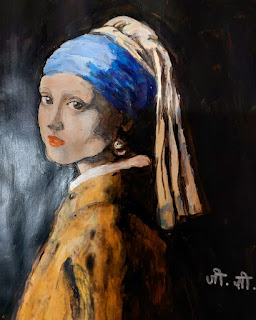Setting a context for my Master Studies, and Migration and Art study
Doing “Master Studies” over the past year or so (see: https://www.instagram.com/gcas0831/?hl=en), has made me aware of a number of benefits that come with serious study and practice of any art (or craft). These include:
1. Learning how to perceive and explore relationships, including :
(a) those between people
(b) those between people and objects and
(c) Those between different parts of objects ie how they form a whole
2. How to think and express oneself:
(a) within the constraints and attributes of a medium.
(b) how to understand the limits (or rules) of a medium or set of conditions and
(c) how to choose when faced with a range of options.
3. How to notice nuance (ie subtleties and sensitivities) and their importance, because what may appear to be a slight difference to me, can make a big difference to other people or to potential results. To be aware of how bias feeds on nuance.
4. The relationship between form and feeling. More specifically form can be used to express feeling. For instance
(a) The shape and colour of buildings or how they are built in relationship to each other can affect our experience of a place
(b) The type of medium and the style we use to communicate in, can affect the way other people receive our message.
5. Experiencing how being flexible has its advantages: There are many different ways to create, even with limited time and resources, being open to exploring possibilities and flexible when working through challenges is essential to reach a goal within a deadline.
6. Language has its limitations. Training oneself to also think in images and symbols increases ones awareness and understanding.
7. Art-making always throws up surprises. It challenges one to look for lessons in mistakes.
8. Trying out different styles of art, by trying to re-create them (or aspects of them) forces one to engage with ideas one would never otherwise consider. It increases one’s exposure to cultures, lifestyles beliefs and thought-processes which are different from “one’s own” in a very positive life-enhancing way.
9. Some art activities are important in themselves, the journey of making them, IS the purpose. For example, we do some things because:
(a) We like the process – play, fun, practicing and mastering a skill
(b) We like the results – a clean house, a good meal, the ability to play an instrument as part of a group
(c) There is a reward – money, recognition, accolades
(d) Because it is the right thing to do
For some time now, I have been considering undertaking a study on art connected with the topic of migration. At the best of times, migration is a topic that evokes strong emotional responses in a lot of people. It is also an exceedingly divisive topic.
As a first generation migrant, this is something I am acutely aware of. I also realise that the migration experience, as well as people’s perception of migrants varies widely. Additionally, there are different categories of migrants and different social and economic conditions at play depending on the countries they migrate to.
I do understand that as someone who migrated to Australia in the skills category - my experience has been very positive. I realise that this is definitely NOT the case for majority of the world’s migrants and that I am certainly not the most qualified spokesperson for them.
That said, I do share with all migrants (internal and international), the losses that are inevitable when you move away from the familiar, from home to an environment (however benign or welcoming) in which you feel like an “outsider” and are perceived as one. With time and familiarity, you begin to feel at home, you develop an understanding of the society into which you move and also of what is possible within it, but loyalties to the home you came from persist. It is potentially a profoundly enriching situation to be in, but it also demands that you expand your skill sets and your mindset in ways in which someone who never made the journey, or someone who has always lived in the receiving society, can never understand.
That is what I was convinced of until I chanced upon some artwork on the topic of migration. Why art? Well, because most of what we feel and perceive simply cannot be articulated in words. This quote from Elliot W. Eisner’s “The Arts and the Creation of the Mind” sums up the value of the arts in assisting us to make sense of what cannot put into words:
"Apart from fostering our awareness of aspects of the world we have not previously experienced in a conscious way, the arts allow us to apply imagination as a means to explore new possibilities… The arts free us from the literal; they allow us to put ourselves in other people's shoes and experience indirectly what we haven't experienced directly. Cultural development depends on these skills and the arts play an extraordinarily important role in contributing to this goal.”






















Comments
Post a Comment